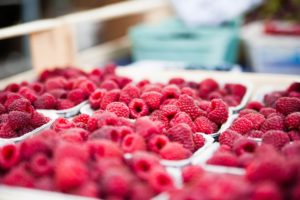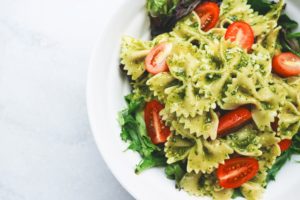 In recent years, many new food labels have taken the world by storm, becoming a popular topic of discussion in the food industry. But of all the food trends—non-GMO, gluten free, local, whole grain, dairy-free, and more—organic is perhaps the first of them all, having been a mainstay on grocery shelves for decades.
In recent years, many new food labels have taken the world by storm, becoming a popular topic of discussion in the food industry. But of all the food trends—non-GMO, gluten free, local, whole grain, dairy-free, and more—organic is perhaps the first of them all, having been a mainstay on grocery shelves for decades.
The modern organic food industry began in the 20th century as a reaction against the increasingly industrialized agriculture industry. Concern about inorganic methods such as the use of pesticides began to take shape in the 1960s and 1970s, and by the 1990s, the retail market for organic was on the rise. As of 2016, the global organic food market reached $89.7 billion USD—and continues to grow.
Simple supply chains
For simple products, ensuring the accuracy of the organic label is relatively straightforward. The supply chain for fresh raspberries, for example, is likely only one or two tiers deep, making it easier for businesses to keep track of. Because the raspberries undergo no transformation before being sold, there are fewer players in the supply chain, and the farm(s) sourcing the produce can be more readily identified.
Of course, as with any food claim, “organic” is not foolproof, even for raw materials. Incidents of food fraud relating to organic goods have arisen in recent years, such as in 2016 when falsely labeled “organic” corn and soybeans were imported into the United States. But generally speaking, shorter supply chains mean fewer chances of tampering, erroneous labeling, and miscommunication, making it easier to ensure all ingredients are organic down to the farm.
The problem with transformed goods
 Yet when it comes to transformed goods—products involving multiple ingredients, and therefore multiple suppliers and facilities in the supply chain—the “organic” label becomes a bigger challenge. Governmental requirements for organic labeling can vary by region and by country, but from a consumer perspective, it is very clear: an organic label can be completely discredited if only one ingredient at any point in the supply chain is not actually certified as organic.
Yet when it comes to transformed goods—products involving multiple ingredients, and therefore multiple suppliers and facilities in the supply chain—the “organic” label becomes a bigger challenge. Governmental requirements for organic labeling can vary by region and by country, but from a consumer perspective, it is very clear: an organic label can be completely discredited if only one ingredient at any point in the supply chain is not actually certified as organic.
For example, a brand selling a ready-made pasta dish must not only ensure that the main ingredients—pasta noodles, sauce, vegetables—are all organic, but that the components that these ingredients are composed of—wheat, spices, onions, oil, etc.—are also organic. This opens up many more points along the supply chain where a supposedly “organic” ingredient can turn out to be just the opposite, dismantling the finished good’s organic label as a whole.
The situation becomes more complex when considering organic’s greater context. Organic food has risen steadily in popularity and consumer demand continues to grow. In 2015, the European organic market increased by 13 percent and reached € 27 billion. Sales of organic food in the United States hit $43 billion USD in 2016, an increase of 8.4 percent from the previous year. In addition, some reports estimate that the global organic food industry will reach anywhere between $200-300 billion USD by 2025, with particularly high growth in the Asia Pacific region.
While this high demand is good for the market, it does not make organic food any easier to produce. Despite high demand, organic farming is greatly limited by the constraints of produce seasonality as well as the high cost and space requirements of organic produce. Therefore, brands who choose to sell organic transformed goods must rely on an even greater number of suppliers to meet growing consumer demand.
To produce enough organic pizzas, for example, a brand may need to rely on multiple tomato farms—each of whom can only supply a limited number of organic tomatoes—to produce the sauce alone. What was potentially one tomato supplier becomes three or four or even more, making the supply chain larger and further fragmented—which ultimately companies to keep track of more suppliers, with more facilities, in more locations.
Addressing the organic challenge
The growth of organic over the years has led to some big challenges. But technology too has evolved, and the era of big data and supply chain digitization can significantly help brands combat the issues that come with organic.
The first step involves identifying and mapping entire organic supply chains to gain visibility into who supplies the ingredients, where they are located, and—importantly—if they are certified organic. The key is to uncover the end-to-end supply chain and eliminate the unknown. From a supplier perspective, supply chain digitization via the Transparency-One platform can also facilitate information sharing with clients, so that an organic certification can be digitized a single time and instantly shared with customers as needed.
Supply chain mapping and digitization can also help prevent fraud, which is an ever-present risk with a market as lucrative as organic. Once fraud has been identified, a digitally mapped supply chain enables companies to identify all products that have been impacted much more quickly. While the consequences of fraudulent organic food labeling is less risky as compared to contaminated goods or fraudulent allergen labeling, the impact on the bottom line and brand reputation can still be substantial, making the ability to move quickly essential.
Other technologies such as blockchain can also be leveraged to provide greater security of supply chain data. For example, companies can add the supply chains of products containing sensitive ingredients such as palm oil to the blockchain to provide additional assurances of data security and chain of custody in case of fraud.
Organic shows no signs of slowing down any time soon. By implementing ways to address the organic industry’s unique challenges, food businesses can ensure success in this thriving market.










